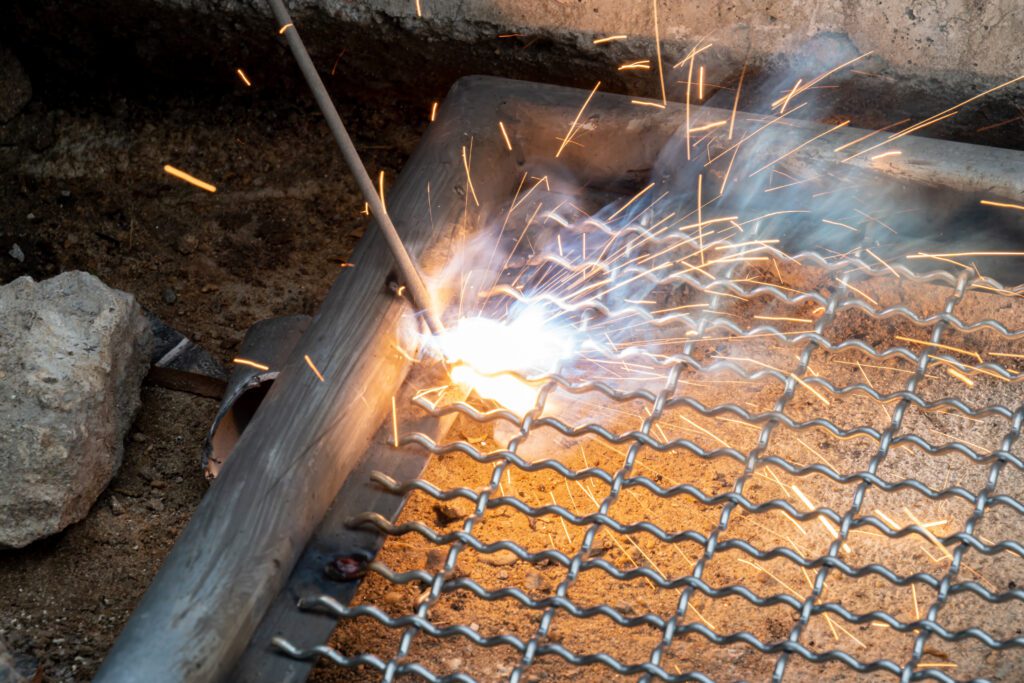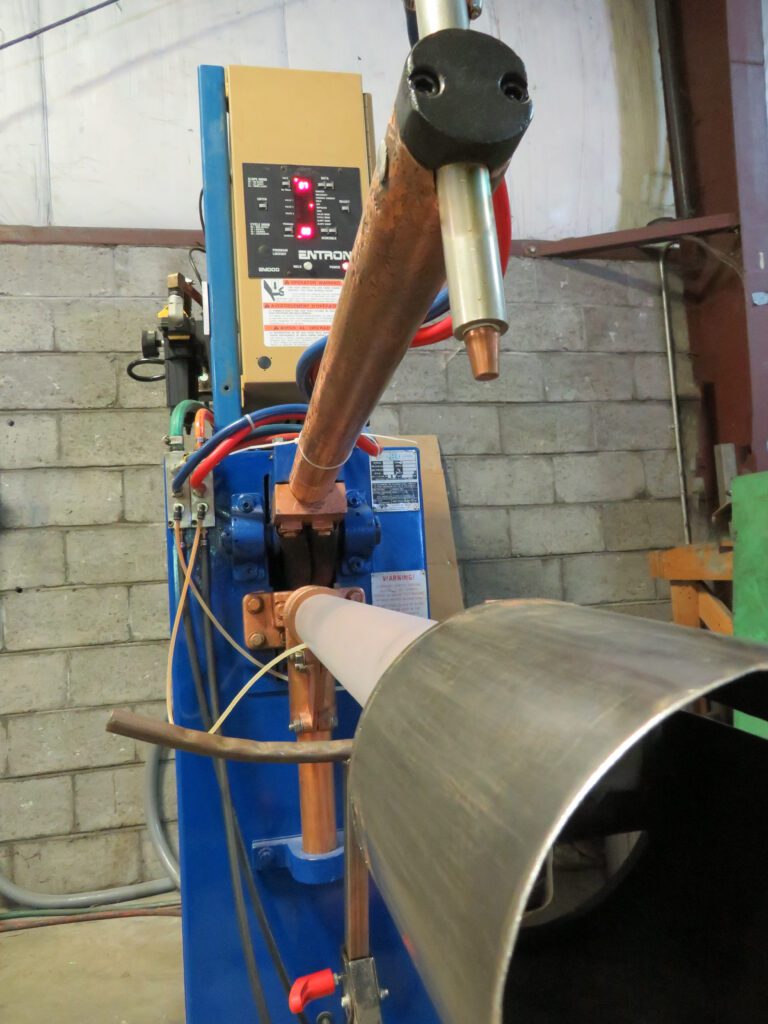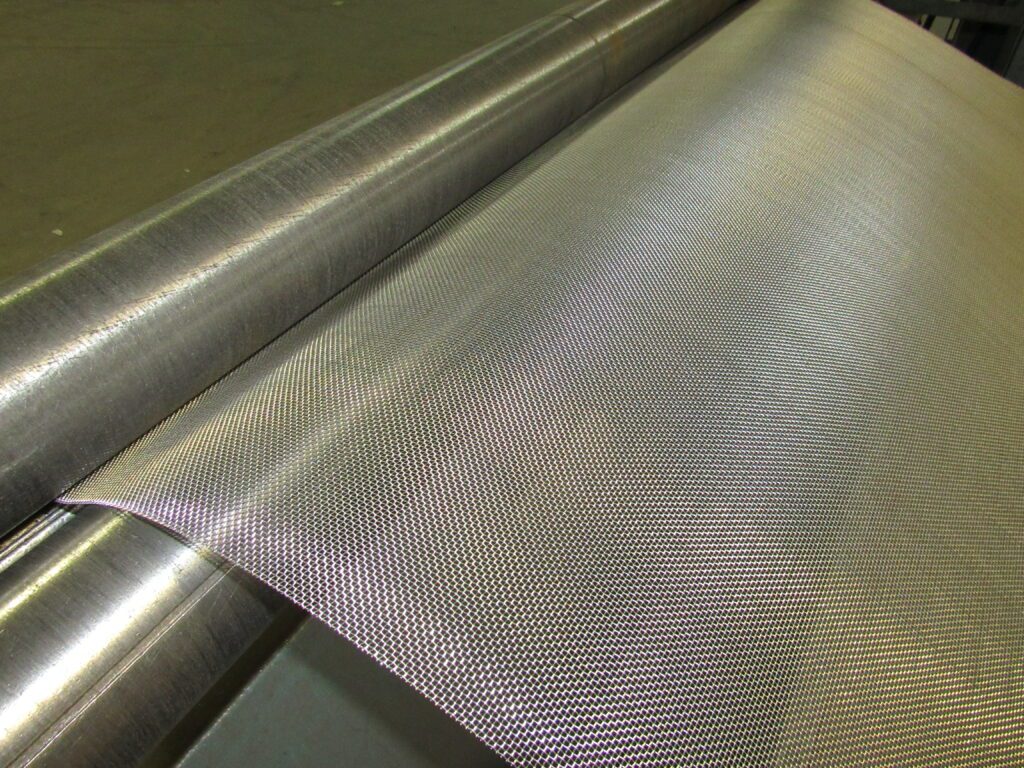
Wire Mesh Fabrications
Wire mesh fabrication creates wire mesh products by cutting, forming, or alternating wire cloth or wire mesh to form a specific finished item.
Here at Universal Wire Cloth, we can take virtually any of our materials and fabricate them into any number of products to meet our customer’s requirements.
Universal Wire Cloth’s Fabrication Capabilities
We have over 30,000 sq. ft of our main warehouse dedicated to fabrication services.
This includes punch presses, sheers, brakes, rollers, and additional equipment to help manufacture almost anything our clients can dream up.
We can handle cutting, shearing, slitting, stamping, notching, forming, welding, edging, rolling, and straightening.
Overview of Fabrication Equipment
Punch Press
A punch press is a machine that punches discs into metal sheets, including wire mesh. The machine uses a punch and die set to cut out the desired shape and size of discs in the wire mesh.
The process begins with a flat sheet of wire mesh being fed into a punch press, with the punch and die set aligned over the area to create discs and scrap material removed to create the desired pattern of discs.
Stamping and notching are two standard techniques in our punch press operations.
Stamping uses a punch and die set to cut or deform metal into desired shapes. It is often used in sheet metal components.
Notching is a technique to cut out a precise shape from a metal sheet or plate, creating a notch for welding, bending, or attaching other components.
Spot Welding Machine
A spot welding machine is a metalworking machine used to create a spot-welded joint between two or more metal sheets. The machine uses pressure and heat to fuse the sheets at specific points along the seam. You can use a spot welding machine to create a cylinder profile.

EDM Wheel Cutting Machine
An EDM (Electrical Discharge Machining) wheel-cutting machine is a precision machining tool used to cut or shape materials, particularly hard materials such as metals and alloys. The machine uses an electrically charged wire, known as an electrode, to erode or cut away the material. We can use an EDM wheel-cutting machine to produce crimping wheels for our weaving process.
Press Brake
A press brake is a machine tool in metalworking that bends sheet metal into a desired shape. The press brake uses a mechanical or hydraulic force to press a metal plate between a punch and a die, creating a bend along a straight axis. Press brakes create hook profiles for our screen sections
Automated Sheers
An automated shear is a machine that cuts sheets of various kinds of metal into specific sizes and shapes. The machine uses a sharp blade, known as a shear blade, to make precise cuts through the metal sheet.
Slitting Machine
Slitting machines are industrial machinery that cut or slit materials into narrower strips or coils, such as metal, plastic, paper, and textiles. They also include edge-trimming, rewinding, and packaging capabilities, allowing for a complete manufacturing process within a single machine, increasing efficiency, and reducing costs.
A slitting machine can cut wire mesh into narrower strips of specific widths.
Slitting wire mesh using a slitting machine is a fast and efficient process producing precise slit-to-width coils.
Rolling Machine
A rolling machine, roll bending machine, or roll former is a device used to shape sheet metal or other materials into cylindrical or curved shapes. In wire mesh fabrication, a rolling machine is commonly used to roll flat wire mesh into cylindrical shapes, such as tubes or cylinders.
Rolling machines are an efficient and cost-effective way to produce cylindrical wire mesh shapes for various applications. They allow for consistent and accurate production of wire mesh cylinders in large quantities. They can be manual or computer-controlled and can be programmed to produce specific shapes with high accuracy.

Most Popular Fabrications
Some of the most popular fabrications include:
Cut-to-size Pieces
Cut-to-size pieces in wire mesh fabrication refer to wire mesh sheets that have been cut into specific sizes and shapes to meet the requirements of a particular application. The wire mesh is typically manufactured in large rolls or sheets, which are then cut into smaller pieces according to the dimensions specified by the customer.
Cut-to-size pieces of wire mesh can be used for a wide range of applications, including filtration, screening, and reinforcement. Depending on the thickness and type of wire mesh used, they can be cut to precise dimensions using various cutting tools, such as shears or laser cutters.
Cylinder Fabrication
Cylinder fabrication is an important process in the wire mesh industry. Cylinders or tubes are formed from wire mesh to create products such as filters, strainers, sieves, and screens. The process typically involves using a rolling machine or a specialized cylinder-forming machine.
Cylinder fabrication requires precision and attention to ensure the final product meets the desired specifications. The first step is selecting the appropriate wire mesh for the application, which is fed into a cylinder-forming machine. The edges of the mesh are joined together using welding or a crimper. Depending on the product, the cylinder may also be assembled with other components.
Stamped Discs
Refer to a fabrication where circular discs are cut from a sheet of wire mesh using a stamping process. Stamped discs are typically a component in various products, including filters, screens, and strainers.
Infill Panels
Wire mesh infill panels are important components of wire mesh fabrication in architecture, construction, and industrial manufacturing.
We offer a diverse range of metals for these panels, which are expertly crafted using a variety of fabrication techniques. Our standard frame is made using quality metal stock. This material is first formed into a “U” shaped metal channel to fit over the outer edges of the wire mesh insert, serving as a frame or border. This edging offers protection against bending or pulling out of the outer side wires. It also acts as a safety feature to prevent damage during handling. The “U” binder edges can be strategically punched with holes to allow for bolting or securing the screen in place. For exterior applications, these holes facilitate drainage of any water accumulation. Optional fixtures or tabs can also be applied to the edging for securing your panels.
Finishing processes, such as polishing or coatings, are available to improve the panels’ appearance and durability.
Screen Sections
Wire mesh screen sections are a vital component in various industrial applications. The screens come in different types and configurations, including vibratory separator screens, sifter/edged screens, and shaker/hooked screens.
Vibratory separator screens sort and classify materials in different industries, such as food processing and mining.
Sifter/edged screens have an added edge frame for added strength, and they are ideal for use in applications requiring a tight fit.
Shaker/hooked screens, on the other hand, have hooks on the edges to facilitate easy installation and removal. These screens separate and classify different materials in the construction and mining industries.
Each type of wire mesh screen section is crafted with precision and expertise to ensure optimal performance and durability.
Click here for more information.
Wire Mesh Fabrication Resources
Types of Wire Mesh Fabrications
Examples of Wire Mesh Products
Common Wire Mesh Construction Styles
Wire Mesh Fabrication FAQs
What is wire mesh fabrication?
Wire mesh fabrication manufactures wire mesh products, such as screens, baskets, trays, and cylinders, using various wire mesh materials, such as stainless steel, brass, and aluminum.
What are the common wire mesh construction styles used in fabrication?
The common wire mesh construction styles used in fabrication include plain weave, intercrimp weave, lock crimp weave, lock crimp x plain weave, flat top weave, and welded wire mesh.
What are the industrial applications of wire mesh fabrication products?
Wire mesh fabrication products are widely used in various industrial applications, such as food processing, pharmaceuticals, chemical processing, recycling, agriculture, mining, and aggregate processing.
